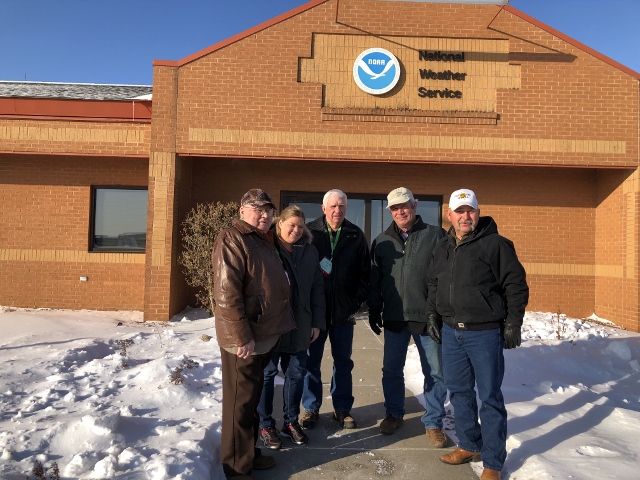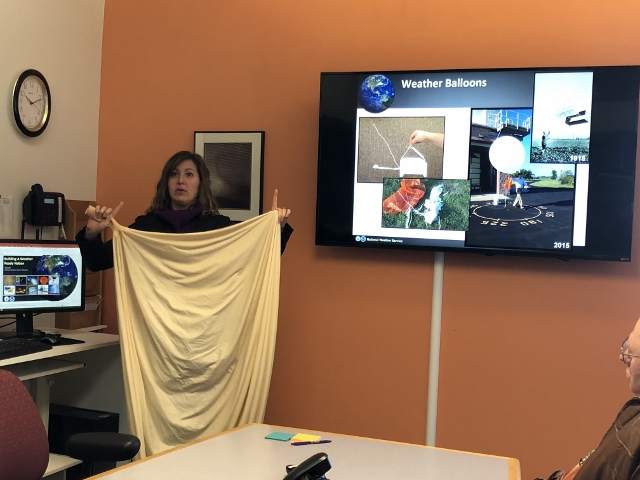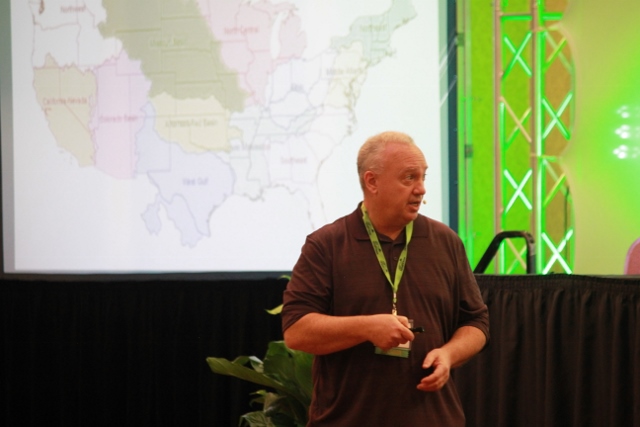Experts Share Weather Outlook & Science Behind Forecasting with SDFU Members
By Lura Roti for SDFU
As a child, Franklin Olson’s grandma told him the way to tell if it’s going to be a wet year is to look at the Big Dipper. “If the Dipper sits on its handle, then it’s not going to rain. If the Dipper is pouring out, then it will rain,” explains the 86-year-old Pierpont farmer and longtime Farmers Union Member.

SDFU members had an opportunity to learn about the science behind weather forecasting through a tour of the National Weather Service Forecast Center in Aberdeen during the 2019 Farmers Union State Convention. Members pictured here include: Franklin Olson, Pierpont; Melissa Wonnenberg, Dallas; Jim Burg, Wessington Springs; David Reis, Oacoma and Terry Sestak, Tabor.
Although she wasn’t a meteorologist, Olson says over the years, her weather prediction methods proved true. During the 2019 S.D. Farmers Union Convention, Olson and other members had an opportunity to learn about the science behind weather forecasting through a tour of the National Weather Service Forecast Center in Aberdeen and learn about 2020 climate predictions from speaker Mike Gillispie, the Senior Service Hydrologist with the National Weather Service in Sioux Falls. “No one watches the weather more than farmers. The weather impacts everything we do,” explains Tabor farmer Terry Sestak, who participated in the tour with Olson.

During the tour, guide Kelly Serr, Warning Coordination Meteorologist with the National Weather Service, explained about the technology, resources and many weather models meteorologists utilize – including helium-filled weather balloons and South Dakotans who volunteer to provide weather data.
“I was impressed with the technology, but also by how simple some of it is,” says Sestak, referencing the weather balloons, which carry tools which measure temperature, humidity, wind speed and other factors 17 miles into the atmosphere.
Serr explained the balloons are released twice daily from many of the 122 National Weather Service Forecast Centers across the U.S. “All the data is pushed to super computers which interpret the data and provide it to us,” she says.

South Dakota has been collecting weather data since 1893, explains Gillispie in his talk. Based on this data, 2019 is the wettest year on record. A fact that does not come as news to South Dakota farmers and ranchers. “Everyone knows it has been wet. How wet and how much has been wet are what are causing the big issues,” he went on to say.
Because the rain kept right on falling throughout harvest, Gillispie says spring 2020 may not bring a reprieve from excess moisture. He used the analogy of a sponge. “You put dry and wet sponges in the freezer. Pull out the dry sponge, pour water over it and the sponge will absorb some water. Pull out the wet sponge, pour water over it and the water will run off because there is no room left in the sponge,” he says. “This is where we are at right now. We’re sitting on a wet sponge and there is nowhere for the water to go.”
“No one watches the weather more than farmers. The weather impacts everything we do.”
Tabor farmer Terry Sestak
Because the entire Missouri River Basin is experiencing wetter than average conditions, Gillispie says we could also see more flooding. The Missouri River Basin covers a region extending from St. Louis to the Montana Rockies.
“This is the reason in one year there have been two record crests along the Big Sioux, Platte Creek and James River,” Gillispie says. “We have never been this wet. The rivers have never been this high this time of year before.” Although his message is not one farmers and ranchers wanted to hear, he did add that not all predictions are a sure thing. “There is a chance for a drier year in 2020. If we don’t pick up snowpack and have a dry March and April. There is a chance it could be better than 2019, but there is also a chance it could be worse.”
He also encouraged farmers to contact him with questions, sharing his email address, [email protected].

